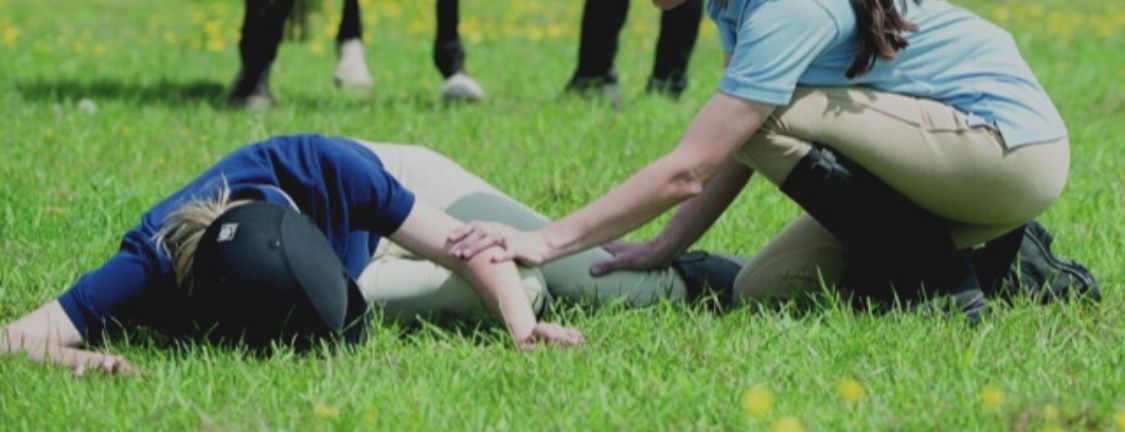
How to deal with serious horse riding injuries
This month’s article from Cory Jones, Director at Medi-K and First Aid Training Co-operative, discusses what basic first aid can be done to help someone with a major traumatic horse riding injury. We hope as horse riders you never have to experience this but should you find yourself in such a situation, knowing the essential skills could make all the difference.
The basics of first aid are often straightforward; making sure you and the casualty are safe, opening airways and making sure the casualty is breathing, keeping limb injuries still and supported, getting help quickly and giving good location information. What riders often ask us about is what to do if there has been a major injury. We hope this short article will give you some simple answers.
How to deal with catastrophic bleeding
Catastrophic bleeding is defined as “extreme bleeding likely to cause death in minutes.” This differs from what we term a significant bleed which is what many of us have seen with simple injuries. Significant bleeding forms a puddle of blood or will soak clothing. Catastrophic bleeding, however, means that the casualty could be losing litres of blood. The wound will be gushing with blood, or blood may be pumping out. In this instance, we must act immediately to help save the casualty's life.
Catastrophic bleeding is usually associated with amputations or significant damage to major blood vessels. These are usually caused by lacerations but can also be caused by complicated fractures where the broken bone damages blood vessels. Where there is a lot of blood, we will need to use something to pack the wound, and we will need a lot of pressure. There are specific bandages, haemostatic dressings, and tourniquets available that help us do that more effectively.
If we don’t have the correct equipment to hand, we need to improvise with anything around us that is absorbent to pack the wound and apply pressure. Bandages and clothing are likely to be the best option. We can also improvise a tourniquet if required by using a bandage or any suitable strap, stirrup leathers can be a good option in times of emergency.
Spine and neck horse riding injuries
Spinal injuries can involve the back or neck bones, intervertebral discs, or spinal cord. These are difficult injuries to manage. One key indicator of spinal injury is the mechanism of the injury which usually involves a fall or impact. Signs of a spinal injury include loss of limb control, casualty complaining about back or neck pain, loss of feeling or a tingling sensation in arms or legs or a loss of bladder/bowel control. If you suspect a spinal injury call for the emergency services immediately and stop all other riding activity around the casualty. Reassure the casualty and maintain an open airway. Keep the casualties "spine in line". A conscious casualty often wants to get up to check if their horse is OK, reassure them their horse is OK and encourage them to lie still. The less movement the better.
Do I remove a riding hat following a fall?
If the casualty is conscious and speaking clearly then leave their hat on. Support their head maintaining 'spine in line'. If the casualty is unconscious and not speaking, then check they have a clear airway and they are breathing. If they are breathing normally with their hat on, then leave it on and wait for medical assistance. Again, support their head maintaining 'spine in line'. If the casualty is vomiting, or there is fluid in their mouth, and they are gagging, then it is essential to clear their airway. This will require their hat to be removed carefully and the casualty being rolled into the recovery position . You can see a video showing you how to remove a helmet here.
Pelvic injuries while horse riding
Pelvic injuries can cause internal bleeding which can lead to shock. The initial injury can sometimes be hard to detect but there may be a history of impact to the abdomen. The signs to look for would be pain around the groin, hips or back increasing with movement, difficulty in passing urine or priapism in men.
It is important to find out the casualty’s history. Was the injury caused by a fall and an impact? If the casualty has a pelvic injury, they will have internal bleeding. The casualty may well show signs of shock which are - feeling cold and being cold to the touch, sweaty clammy skin, feeling anxious, fast shallow breathing. These casualties need immediate evacuation by the emergency services. Don't let them have anything to eat or drink. If the casualty becomes unconscious, carefully place them in the recovery position. Do not move the casualty unless there is an emergency. Call 999 and let the emergency service know you suspect a pelvic fracture. Keep the casualty reassured and warm. You could immobilise their legs by tying them together.
About First Aid Training Co-operative and Medi-K
They work together to run highly respected equestrian specific first aid courses. Cory has been running first aid courses for outdoor workers for over 20 years and along with the training team at Medi-K, Cory has developed an equestrian first aid manual that can be downloaded to your phone or tablet.
